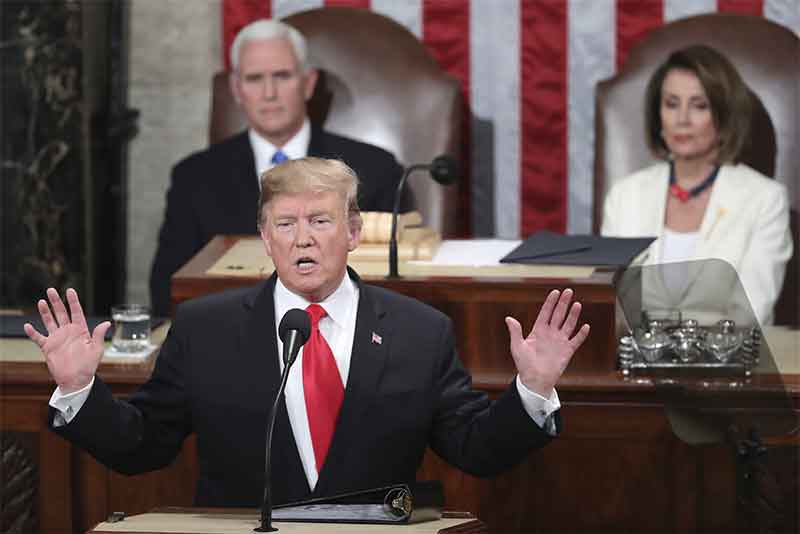
As rich countries switch on their firefighting mode to tame soaring inflation, developing countries are feeling the heat. Higher interest rates mean increased debt servicing costs. Hawkish interest rate hikes are also triggering net capital outflows and currency depreciations, adding to the woes caused by commodity price volatilities and US-led trade disruptions.
Thus, an increasing number of developing countries are in debt distress and seeking help from the International Monetary Fund (IMF). Scapegoating China distracts from the root causes of the problem.
Rising debt becoming more risky
Close to 60% of the poorest countries were already in debt distress or at high risk of it before the Ukraine crisis. Debt-service burdens in middle-income countries were at 30-year highs. Like the 1980s, interest rates are rising across the world, amidst rising food, fertilizer and fuel prices.
Developing countries’ external debt has been rising since the 2008-2009 global financial crisis (GFC), from around US$2 trillion (tn) in 2000 to US$3.4tn in 2007 and to US$9.6tn in 2019. External debt as a percentage of GDP fell from 33.1% in 2000 to 22.8% in 2008; but due to sluggish growth since the GFC, it rose to 30% of GDP in 2019 prior to the pandemic.
In 2020, the pandemic pushed developing countries’ external debt stocks to US$10.6tn, or 33% of GDP, the highest level on record. Excluding China’s borrowing, external debt-GDP ratio of developing countries stood at 44% in 2020.
At the same time, developing countries’ debt profile has also become riskier with the changes in public-private composition of debt and increased borrowings from international capital markets. For instance, the share of private short-term debt rose from US$315 bn in 2000 to US$2.7tn in 2020 (i.e., from 16% to 26% of total external debt), and public external debt from the international capital markets increased from 43% to 62% during the same period.
Long-term private unguaranteed debt also exceeded public debt. Even though these private debts are not government guaranteed, in reality they end up with the government in the event of a default, thus increasing the government’s contingent liabilities. Borrowing from private capital market accelerated after 2008-2009 GFC.
For example, Sri Lanka’s (SL) borrowings from international capital market grew rapidly from merely 2.5% of foreign debt in 2004 to 56.8% in 2019, and with it the US dollar denominated debt share rose sharply – from 36% in 2012 to 65% in 2019.
In contrast, Chinese debt was about 10% of SL’s total external debt as from other bilateral lenders (e.g., Japan), including the Asian Development Bank and the World Bank. Adding government guaranteed debt to state-owned enterprises, total borrowings from China were 17.2% of SL’s total public foreign debt liabilities in 2019.
Borrowings from international capital markets are more burdensome. This is because interest rates charged to developing countries are much higher as they are perceived riskier; commercial debts are of shorter duration, typically less than 10 years; and commercial lenders do not offer many restructuring or refinancing options.
SL’s debt owed to private capital markets of less than 10 years’ durations constituted about 60% of SL’s debt as of April 2021. The effective interest rate on commercial loans in January 2022 was 6.6% – more than double that for Chinese debt. Unsurprisingly, SL’s interest payments alone came to 95.4% of its declining government revenue in 2021!
Similarly, private sector debt, mostly driven by sovereign borrowing through Eurobonds, makes up 30% of the Africa’s total external debt while Chinese loans constitute around 17%. For Ghana, 57% of external-debt payments go to private lenders. Zambia’s commercial debt rose from a negligible 1.6% of total external debt in 2010 to about 30% in 2018! Nigeria’s 60% of debt servicing goes towards servicing Eurobonds, while it is 40% in the case of Kenya.
Push for commercial borrowing
There are a number of push factors for such developments.
First, the failure of most rich countries to fulfil annual aid disbursements of 0.7% of their gross national income (GNI) – a promise made more than half a century ago. Worse, the share has actually declined from 0.54% in 1961 to around 0.33% in recent years, with only five nations consistently meeting their 0.7% commitment. Oxfam has estimated that in the 50 years since the 0.7% promise was made, high income countries have failed to deliver a total of US$5.7tn in aid.
Second, claiming superiority of private finance, the World Bank and donors floated the idea “From billions to trillions: converting billions of official assistance to trillions in total financing” using such vehicle as ‘public-private partnership’ (PPP) and ‘bended finance’ (BF). While these have dubious sustainable development outcomes, especially poverty reduction and promoting equity and health, they impose financial burdens on the government’s budget directly and indirectly.
Third, accommodative monetary policies in many developed economies, e.g., quantitative easing and zero or negative real interest rates, since the GFC encouraged fund managers, aided by rating agencies, to look for better returns in developing countries. Typically influenced by the large investment funds, rating agencies conferred various epithets, such as “emerging economies” and “frontier economies” to encourage developing countries to float sovereign bonds in international capital markets.
Aggravating factors
Further aggravating factors are policy advice from donors and multilateral development banks (MDBs), rating agencies’ bias against developing countries and the lack of an orderly mechanism for fair sovereign debt-restructuring involving commercial lenders.
Ideologically favouring market solutions, donors, MDBs and IMF have been advising against pro-active industrial development and structural transformation strategies since the late 1970s. Thus, many developing countries remained primary producers with a very narrow export base and volatile export earnings.
Donors, the MDBs and the IMF have also been encouraging tax cuts, arguing that they are necessary to attract foreign direct investment (FDI). The World Bank has been particularly notorious in encouraging competitive tax cuts through its ideologically biased but influential “Doing Business Report”. However, there have been net revenue losses as such tax cuts hardly incentivised FDI. Multinational corporations’ (MNCs) tax evasions and avoidance have exacerbated developing countries’ revenues losses.
Credit rating agencies often rate developing countries unfavourably thus pushing up borrowing cost significantly. The rating agencies are also quick to downgrade developing countries’ credit rating at every sight of economic difficulty regardless of their sources, such as the pandemic, effectively making it harder for them to obtain refinancing at reasonable rates during their greatest needs even though the economic fundamentals of many remained sound.
While debt distress is often due to unfavourable circumstances, the lack of an orderly and fair debt restructuring mechanism creates a vicious cycle. Even though commercial lenders charge many-fold higher interest rates to cover default risks, when default becomes a reality, they refuse to refinance, restructure or provide any relief, e.g., refusal to participate in the G20’s debt suspension initiative. Instead, they act like vultures preying on vulnerable countries.
Western debt trap
Following the 1970s oil price hikes, Western banks, especially those in the US, had excess liquidity as oil-exporting countries’ dollar reserves with them swelled. These banks then encouraged Latin American and other developing countries to borrow, offering them lower interest rates.
When the US Fed began raising interest rates from 1977 to fight inflation, other major banks also followed. Thus, these countries’ debt service burden suddenly rose. The ensuing US recession and global economic slowdown meant falling export revenues for commodity-exporting developing countries in Latin America and Sub-Sharan Africa.
Debt-distressed countries were forced to seek financial support from the IMF and the World Bank, but had to agree to severe austerity measures and liberalisation and privatisation reforms – dubbed as “Washington consensus”. Such reforms only benefited Western MNCs and agri-businesses, particularly from the US, as admitted by President Clinton in the case of Haiti. Meanwhile, Latin America and Sub-Saharan Africa suffered “lost development” decades with declining per capita income.
Chinese debt trap or the replay of the 1980s?
Serious Western research, such as by London’s Chatham House concluded that the China debt-trap diplomacy narrative is simply wrong. The Atlantic of 6 February 2021 argued, ‘The Chinese “Debt Trap” Is a Myth’.
Meanwhile, developing countries are increasingly trapped into international capital markets. They are also facing higher food, fertilizer and fuel prices, mainly due to US-EU led sanctions against Russia, putting stress on developing countries’ foreign currency reserves.
US-UK-ECB led interest rate hikes are causing an exceptional episode of capital outflows, higher than in the GFC’s aftermath, from developing countries, causing further depletion of foreign reserves and currency depreciations. Higher interest rates, capital flights, currency depreciations, and higher import costs are adding to the debt distress.
Thus, many vulnerable countries, such Bangladesh and Pakistan are seeking financial help from the IMF, as commercial lenders refuse to restructure and give debt relief. But, the IMF imposes ‘one-size-fits-all’ austerity measures, impairing social cohesion and growth prospects – a devil’s bargain.
On the other hand, China recently announced forgiveness of 23 loans for 17African countries, debunking the China debt trap narrative.
Dr Anis (Anisuzzaman) Chowdhury is Adjunct Professor, School of Business, Western Sydney University (Australia). He was Director of Macroeconomic Policy and Development Division and Statistics Division of the UN Economic and Social Commission for Asia and the Pacific (UN-ESCAP, Bangkok) and Chief, Financing for Development Office of the UN Department of Economic and Social Affairs (UN-DESA, New York). Prior to joining the United Nations in 2008, Dr Chowdhury was Professor of Economics, Western Sydney University. He also taught at the University of Manitoba (Canada), National University of Singapore and the University of New England (Australia). He has published over two dozen books and close to 100 academic articles on development and macroeconomic issues. He has also edited two books on Moulana Bhashani.













































